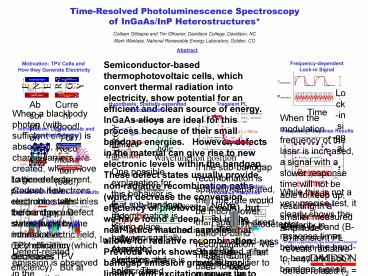TimeResolved Photoluminescence Spectroscopy of InGaAsInP Heterostructures PowerPoint PPT Presentation
Title: TimeResolved Photoluminescence Spectroscopy of InGaAsInP Heterostructures
1
Time-Resolved Photoluminescence Spectroscopy of
InGaAs/InP Heterostructures Colleen Gillespie
and Tim Gfroerer, Davidson College, Davidson,
NC Mark Wanlass, National Renewable Energy
Laboratory, Golden, CO
Abstract Semiconductor-based thermophotovoltaic
cells, which convert thermal radiation into
electricity, show potential for an efficient and
clean source of energy. InGaAs alloys are ideal
for this process because of their small bandgap
energies. However, defects in the material can
give rise to new electronic levels within the
bandgap. These defect states usually provide
non-radiative recombination paths (which decrease
the conversion efficiency of photovoltaic cells),
but we have found a deep level in the
near-lattice matched samples that allows for
radiative recombination. Previous work shows
that sub-bandgap emission grows super-linearly
with excitation power up to and exceeding 1000
W/cm2. This unusual result suggests that the
defect-related radiative process is complex. We
hypothesized that the electrons and holes are
physically separated at the defect sites, so that
increasing excitation leads to an increase in
electron-hole wavefunction overlap and an
increased recombination rate. If the electrons
and holes are spatially separated, the resulting
transition times should generally be much longer
than those of the band-to-band transitions. We
have measured the sub-bandgap and band-to-band
recombination rates and find that our
experimental results are inconsistent with the
spatial separation model.
Hypothesis Spatially-separated Recombination
- Conclusions
- Band-to-band (B-B) transient PL reveals radiative
(t1 47ns) and defect-related (t2 920ns)
mechanisms as expected. - Sub-band gap (SBG) and B-B response times are
similar (approximately 1 microsec). - Results are inconsistent with spatial separation
hypothesis. - The similiarity in SBG and B-B response indicates
that the mechanisms are more closely related than
expected.
Project supported by the American Chemical
Society Petroleum Research Fund
PowerShow.com is a leading presentation sharing website. It has millions of presentations already uploaded and available with 1,000s more being uploaded by its users every day. Whatever your area of interest, here you’ll be able to find and view presentations you’ll love and possibly download. And, best of all, it is completely free and easy to use.
You might even have a presentation you’d like to share with others. If so, just upload it to PowerShow.com. We’ll convert it to an HTML5 slideshow that includes all the media types you’ve already added: audio, video, music, pictures, animations and transition effects. Then you can share it with your target audience as well as PowerShow.com’s millions of monthly visitors. And, again, it’s all free.
About the Developers
PowerShow.com is brought to you by CrystalGraphics, the award-winning developer and market-leading publisher of rich-media enhancement products for presentations. Our product offerings include millions of PowerPoint templates, diagrams, animated 3D characters and more.

